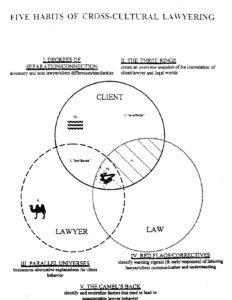We developed five Habits of Cross-Cultural Lawyering in 1999 to provide teaching and practice materials about cross-cultural lawyering in clinical legal education. We believe that all lawyering is cross-cultural, so teaching about cross-cultural lawyering is necessary if clinical students are to provide quality representation to their clients. We also believe that the measure of good cross-cultural lawyering is the respect a lawyer has for her client’s dignity, voice, and story, and the lawyer’s understanding of her own biases and ethnocentric world views. The five Habits can enable lawyers to show their clients this respect and develop this understanding.
Information to introduce the Habits can be found here.
The five Habits are as follows:
• Habit One, Degrees of Separation and Connection, invites lawyers to explore how similarities and differences with the client might influence their relationship and fact gathering.
• Habit Two, The Three Rings, expands the focus of Habit One to include the cultural dimensions of the case or project with a goal of strengthening the client’s legal claim. Habit Two considers similarities and difference between the lawyer and the law; the law and the client and the client and the lawyer.
• Habit Three, Parallel Universe Thinking, invites lawyers to identify alternative explanations for observed phenomena before acting upon any conclusions in order to destabilize the lawyer’s certainty about the meaning of others’ actions.
• Habit Four, Red Flags and Correctives, encourages lawyers to reflect on communication before, during and in between client encounters in order to troubleshoot problematic interactions.
• Habit Five, The Camel’s Back, addresses the inevitable moments when the lawyer blunders cross-culturally. Like the proverbial straw that breaks the camel’s back, any one of a multitude of stressors can become the final factor which leads to a cross-cultural mistake. Habit Five, The Sadder but Wiser Habit, looks retrospectively at a problematic moment to identify factors that likely led to a cross-cultural mishap and to eliminate those factors in the future.

